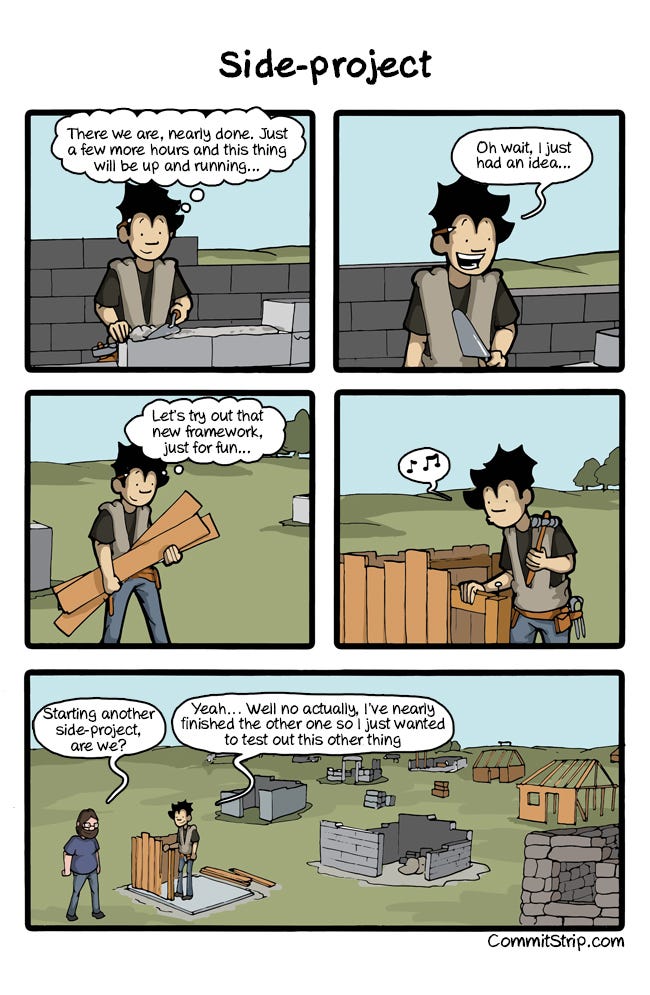Publish Your Side Project, Now!
If you’re not embarrassed by your first release, you’ve launched too late.

Photo by Caleb Woods on Unsplash
Outside of day-to-day jobs, most developers have projects on the side. Not so many however publish them.
Working on side-projects brings many benefits for developers. They are a great way to learn new technologies and enhance your current skills. But, most importantly, it is fun to develop a project from the ground up on an idea you came up with. You can unleash your full creativity. There are no constraints that you might have in your full-time job.
For many developers, programming is a labor of love. — StackOverflow
According to the StackOverflow Survey in 2015, 91.7% of developers had active side projects. For me, that is astonishing. Unfortunately, the survey does not reveal how many of them ever made anything public. Without proving it empirically, I would say that only very few side projects are ever released.
The average developer spends more than 7 hours per week coding on the side. — StackOverflow
In my opinion, that lies in the fact that many developers continue developing their side projects for years. They spent hours creating a product without ever publishing it. Why? Because despite dreaming about making money through their product, the real potential of launching a product nobody likes is far scarier than developing a product nobody’s heard of.

Of the several side-projects, I have started, I only published one — the Web Highlights Chrome extension. I remember very well when I first published the extension in the Chrome Web Store. Was I concerned that nobody likes the extension? Yes. Was I concerned that users would complain about bugs? Yes.
But more importantly, was I excited to publish my first side-project publicly in the Chrome Web Store? Yes, I was. So, what happened? Did I launch a product nobody likes?
Let’s put it that way: It could have started better. After one month, I have had four users — Me, my brother, my mum, and a friend. Two months later, I have had eight users — Me, my brother, my mum, and five friends. My brother used to be (and still is) a “bug-hunter” and always sent me screenshots to fix stuff and my friends were more or less using it to do me a favor. But, I remember the day on March 12th, 2020 — The first unknown user signed up. I couldn’t be happier!
After a year, I was a proud developer of an extension with 123 active users. Meanwhile, there are 2906 active users. This is still not an overwhelming amount. But much more important to me is that many users love the application as much as I do.

So ask yourself: What could happen? It might be that nobody will notice your product. Or maybe, users will not like your product and will get rid of it again. You might also receive negative reviews. So what?
We can be truly successful only at something we’re willing to fail at. If we’re unwilling to fail, then we’re unwilling to succeed. — Mark Manson
It would be best to establish a mindset where failure is not a bad thing. Actually, failure is necessary for growth. Let me emphasize that by quoting Mark Manson:
If you think about a young child trying to learn to walk, that child will fall down and hurt itself hundreds of times. But at no point does that child ever stop and think, “Oh, I guess walking just isn’t for me. I’m not good at it.” Avoiding failure is something we learn at some later point in life.
Projecting this to side projects means that even if your first side project is not a success. Maybe your second, third, or fifteenth is. Never give up and realize that at the end of all of your projects — whether successful or unsuccessful, paid or unpaid, finished or unfinished — you will always win: new experiences, new contacts, and new findings about yourself!
I have not failed. I’ve just found 10,000 ways that won’t work. — Yevgeniy Brikman
Another significant advantage of publishing your side project is the opportunity to show your work to others. When interviewing for development jobs, it’s not uncommon to be asked if you’ve completed any side projects. Having a GitHub profile is also expected in many cases, and potential employers may ask to see your profile. I can say that having a running Chrome extension with several hundred users caused amazement during my job interviews as an entry-level employee.
Final Thoughts
Developers often take on side projects. However, it’s a common scenario that many of these side projects will sink into oblivion. Do you have a side project? Don’t be afraid to show it! I hope this article can finally motivate you to publish your side project. Launching your product is the very first step towards an exciting future.
If you are interested in the whole story of my Web Highlights side-project, you might want to read My Journey to the First $ 9.99 with My Side Project.
I hope you enjoyed reading this article. I am always happy to answer questions, and I am open to criticism. Feel free to contact me at any time 😊
Get in touch with me via LinkedIn or follow me on Twitter. Also, check out my PDF & Web Highlighter Chrome extension if you haven’t.
